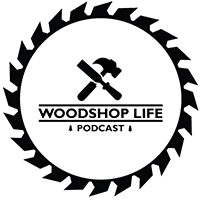Support us on Patreon: https://www.patreon.com/woodshoplife
Guy
1)When is the right time to pull the trigger? I’m currently using an old Grizzly 6″ jointer that works fine but limits me in terms of both width and length of stock. What measurements or guidelines do you all use to determine when it’s time to upgrade your shop equipment? Joel
2) Right now I’ve really been trying to take time to learn and be comfortable with the foundational skills; practicing cuts and joinery. Do you have any tips on how to make more accurate angled cuts? For example, I started just making and octagon shaped frame this weekend. Getting all angles and lengths to perfectly match took way too many attempts 🤦♂️. Is this something you prefer a miter saw or table saw for? Any tools or accessories you suggest using that can be used to double check your saw blades are at the proper angle? Etc. Right now I have a cheap miter saw and a dewalt jobsite table saw. I know the tools aren’t the best, but I’m sure there are some things I could start doing and making into habits to get better as I start into this new hobby! -Brandon
Sean
1) Hey guys, could you recommend a mobile (2 stage) dust collection system for a hobbyist woodworker? I’m not looking to wall mount as I’m both, in a small space, and not in my “forever” shop. Perhaps DIY (where to start?) or from any brands is suitable. I don’t really know where to begin. Currently run a jobsite table saw, and looking to add a jointer and planer soon. 4” intake is preferred. Thanks! RJ
2) Questions for the podcast: is the Festool Domino worth it? Context: building a bar and stools out of 8/4 ash and need something to quickly join the legs of the stools together, as well as the bar and legs. I originally thought dowels or router out for loose mortise and tenon, but time is money, literally, as this is a project for a client. Should I spend the $1000+ for the domino, and save time, which allows me to get other client projects done (could use the domino on some of those projects too) or, save the $1000k, do it with dowels or a router and then spend the $1000+ on a delta tablesaw and a dewalt 735x planer? Planer would need to be on sale for the numbers to line up (bad at math!). I currently have a 1/2 hp craftsman table saw with upgraded fence. Thoughts? Thanks! Love the podcast! Thelibertycraftsman
Huy
1)Thanks for the time you invest in the podcast. I have been woodworking a long time but I am still learning. I do not make furniture but I still pick up lots of tips from you three. I am new to the bandsaw. I have a Laguna 14 Twelve. I mainly resaw logs for bowl blanks, since I do a lot of turning. I have been using a Laguna Proforce 3/4″ 3 tpi. The blade broke though it is only a couple months old and I have only milled about 3 dozen blanks. What are the causes for such a blade to break? I would appreciate any insight, so as to avoid breaking the new blade. Thanks. -Mark
2)The talk about bringing all sorts of lumber into your shop, like from a pile outdoors under a tin cover, has me wondering about contamination. Basically, were talking about a biodegradable material here, which starts growing microbial life on, in, and off it as soon as the tree dies. So is there ever any danger of bringing wood into your storage which infects your entire stock? Relatedly, should we never machine any rotting material because that would make the fungus etc airborne and infect the whole shop? -Warren
